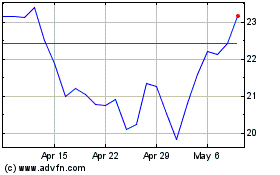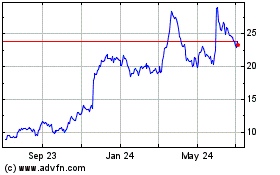Zara Owner Inditex's Profit Beats Expectations -- Update
September 21 2016 - 3:07AM
Dow Jones News
By Patricia Kowsmann
Inditex SA, the retailer behind the Zara fast-fashion chain,
reported a better-than-expected rise in first-half net profit,
continuing to benefit from its focus on easily renewed inventory
and quick deliveries to drive up sales.
The world's largest fashion retailer by revenue said on
Wednesday that net profit rose 7.7% to EUR1.26 billion in the six
months to end-July from EUR1.17 billion in the same period last
year on an 11% rise in sales to EUR10.47 billion. Based on
Inditex's first-quarter report, that implied an 8.8% rise in
second-quarter profit to EUR645 million on an 11% rise in sales to
EUR5.59 billion.
Inditex, whose official name is Industria de Diseño Textil SA,
said sales continued to grow in recent weeks, with 13% growth in
physical and online sales in constant currency terms between Aug. 1
and Sept. 18.
The clothing supplier's robust growth, ahead of the average of
analysts' second-quarter forecasts, contrasts with many of its
rivals' recent performance.
Gap Inc. reported falling second-quarter sales as retailers in
the U.S. continued to struggle with shrinking foot traffic and
growing competition among companies seeking to deliver quicker and
cheaper fashion. Inditex's closest competitor, Swedish fast-fashion
giant Hennes & Mauritz AB, last week said August sales were hit
by an unusually hot late-summer weather. Overall, H&M's sales
growth has lagged behind that of Inditex, which has more physical
stores.
Analysts say Inditex has an edge over rivals because of its
centralized operations in Spain and close-by production centers.
According to Société Générale, while 65% of its products are
sourced in Spain, Portugal, Turkey and North Africa, most other
retailers source about 80% of their products from Asia.
The proximity allows Inditex to quickly respond to customer
demand, new tastes and even the weather, which in turn gives it a
pricing power rivals like H&M don't have.
"We continue to believe Inditex is a structural winner with its
strong brand and well adapted business model," Berenberg analysts
said in a note.
Inditex's pricing power means it can offer customer-friendly
services, including free online delivery and returns, without
hurting margins, according to Société Générale analyst Anne
Critchlow. Its centralized operations, meanwhile, make the cost of
adapting its business to cope with growth in online shopping lower
than at H&M, for instance, which has several warehouses spread
around the globe.
Ms. Critchlow estimates online sales should account for roughly
6% of overall sales this year, leaving it with much room to
grow.
While online offers expand, the company has vowed to slow down
the pace of retail space growth over the years and focus on the
more profitable flagship stores. In the first half of the year,
Inditex opened 83 stores, bringing the total number to 7,096
world-wide. Out of 92 markets where it is present, 39 have online
stores.
Analysts polled by Thomson had expected second-quarter net
profit of EUR691 million on sales of EUR5.57 billion.
Write to Patricia Kowsmann at patricia.kowsmann@wsj.com
(END) Dow Jones Newswires
September 21, 2016 02:52 ET (06:52 GMT)
Copyright (c) 2016 Dow Jones & Company, Inc.
Gap (NYSE:GPS)
Historical Stock Chart
From Mar 2024 to Apr 2024

Gap (NYSE:GPS)
Historical Stock Chart
From Apr 2023 to Apr 2024
